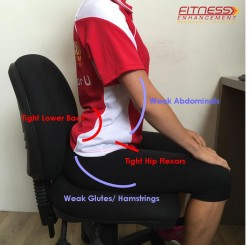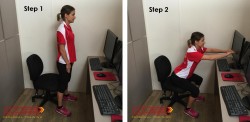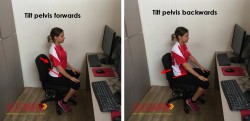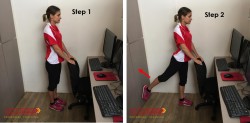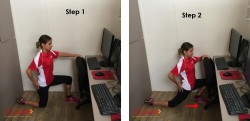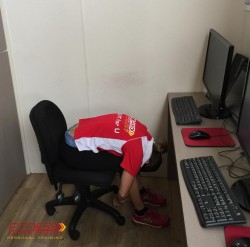Lower back pain is one of the most common chronic pain complaints we come across. What causes so many people to have lower back pain? For the majority of us, it’s largely due to our posture. We spend so many hours a day sitting down whether it’s in the office, in the car, at the dinner table or on the couch. When we sit down it keeps our hips in a flexed position, which causes tightness in the hip flexors and lower back muscles, and weakness in the glutes and abdominals.
The mistake a lot of people make is thinking that they need to REST when their lower back is sore, when in actual fact the best thing to do is GET MOVING! We need to stretch the muscles that are too short and tight, and strengthen the muscles that are too long and weak. Here are 6 simple exercises and stretches you can do in the office to help with this problem.
See us demonstrate the back exercises
Lower back exercise # 1: Walking
Just the simple act of getting up out of your chair and going for a walk is a fantastic way to take your hips out of their flexed position and get them moving. If you sit at a desk all day try getting up at least once an hour for a quick walk around the office, to the bathroom, or walk around the block on your lunch break.
Lower back exercise #2: Body weight squats
Squatting is a fantastic exercise to strengthen your large glute muscles as well as your quads and hamstrings, which will help take strain off your lower back muscles. You don’t have to go to a gym and have a heavy weight on your back to get the benefits of a squat. In fact you can squat by simply getting and and down from your office chair. Keep your feet just wider than your hips, keep your knees behind your toes, head up and squat down. Whenever you need to pick something off the floor – squat, reaching down to the bottom of the fridge – squat, why not kill two birds with one stone and even do some squats while you wait for the photocopy machine.
Lower back exercise #3: Pelvic tilts
Pelvic tilts are a very small movement where you simply tilt your pelvis backwards, and then forwards. When you have tight lower back muscles, your pelvis is usually tilted FORWARDS, making your lower back arch and your tummy stick out. To strengthen your abdominals, try to tilt your pelvis BACKWARDS, rounding your low back slightly and crunching your abs. You can do this while you’re sitting at your desk, you can also do it sitting on a Swiss ball for a bit more movement. Try to do as many as you can, whenever you think of it.
Lower back exercise #4: Hip extensions
Extending your hip helps to strengthen the OPPOSITE muscles to your tight hip flexors, and can help to pull the pelvis back into alignment. Standing up either behind your desk chair, or holding onto a wall, put all your weight on one foot and extend your opposite hip by squeezing your glutes (butt muscles) and lifting your leg backwards, with your toes facing the floor. Be careful not to arch yourlower back – focus on keeping your pelvis tilted backward. Repeat multiple times on both sides.
Lower back exercise #5: Hip flexor stretch
OK so these last two ‘exercises’ are technically stretches. If your hip flexors are tight, they pull your pelvis forward and cause your lower back to arch and back muscles to become tight and sore. To stretch your hip flexors you get into a ‘proposal position’, kneeling on one knee with opposite foot flat on the floor, keep your chest up, and simply lean forward into a ‘lunge’ movement until you feel tightness in the front of your hip. Hold for 30-60 seconds and repeat on the opposite leg.
Lower back exercise #6: Lower back stretch
Tight lower back muscles are the major culprit for ongoing pain in the low back, so regular stretching is important to help reduce the tension. Sitting at your desk, simply bend forward and reach your hands towards the floor, bring your head between your knees (or as close as possible) and relax into the stretch. Hold for 30-60 seconds.
These simple exercises will be a great starting point in reducing your lower back pain while you’re AT work but it’s also important that you are doing regular full-body strengthening exercise to maintain your core strength and stability, as well as regular stretching to keep your body in balance. Prevention is always better than treatment!

